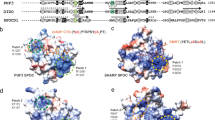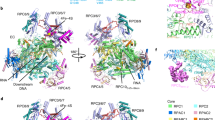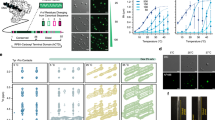Abstract
The C-terminal domain (CTD) of the large subunit of RNA polymerase II is a platform for mRNA processing factors and links gene transcription to mRNA capping, splicing and polyadenylation. Pcf11, an essential component of the mRNA cleavage factor IA, contains a CTD-interaction domain that binds in a phospho-dependent manner to the heptad repeats within the RNA polymerase II CTD. We show here that the phosphorylated CTD exists as a dynamic disordered ensemble in solution and, by induced fit, it assumes a structured conformation when bound to Pcf11. In addition, we detected cis-trans populations for the CTD prolines, and found that only the all-trans form is selected for binding. These data suggest that the recognition of the CTD is regulated by independent site-specific modifications (phosphorylation and proline cis-trans isomerization) and, probably, by the local concentration of suitable binding sites.
This is a preview of subscription content, access via your institution
Access options
Subscribe to this journal
Receive 12 print issues and online access
$189.00 per year
only $15.75 per issue
Buy this article
- Purchase on Springer Link
- Instant access to full article PDF
Prices may be subject to local taxes which are calculated during checkout







Similar content being viewed by others
Accession codes
References
Howe, K.J. RNA polymerase II conducts a symphony of pre-mRNA processing activities. Biochim. Biophys. Acta 1577, 308–324 (2002).
Proudfoot, N.J., Furger, A. & Dye, M.J. Integrating mRNA processing with transcription. Cell 108, 501–512 (2002).
Bentley, D. The mRNA assembly line: transcription and processing machines in the same factory. Curr. Opin. Cell Biol. 14, 336–342 (2002).
Komarnitsky, P., Cho, E.J. & Buratowski, S. Different phosphorylated forms of RNA polymerase II and associated mRNA processing factors during transcription. Genes Dev. 14, 2452–2460 (2000).
Buratowski, S. The CTD code. Nat. Struct. Biol. 10, 679–680 (2003).
Ahn, S.H., Kim, M. & Buratowski, S. Phosphorylation of serine 2 within the RNA polymerase II C-terminal domain couples transcription and 3′ end processing. Mol. Cell 13, 67–76 (2004).
Cho, E.J., Kobor, M.S., Kim, M., Greenblatt, J. & Buratowski, S. Opposing effects of Ctk1 kinase and Fcp1 phosphatase at Ser 2 of the RNA polymerase II C-terminal domain. Genes Dev. 15, 3319–3329 (2001).
Hani, J. et al. Mutations in a peptidylprolyl-cis/trans-isomerase gene lead to a defect in 3′-end formation of a pre-mRNA in Saccharomyces cerevisiae. J. Biol. Chem. 274, 108–116 (1999).
Gross, S. & Moore, C. Five subunits are required for reconstitution of the cleavage and polyadenylation activities of Saccharomyces cerevisiae cleavage factor I. Proc. Natl. Acad. Sci. USA 98, 6080–6085 (2001).
Barilla, D., Lee, B.A. & Proudfoot, N.J. Cleavage/polyadenylation factor IA associates with the carboxyl-terminal domain of RNA polymerase II in Saccharomyces cerevisiae. Proc. Natl. Acad. Sci. USA 98, 445–450 (2001).
Sadowski, M., Dichtl, B., Hubner, W. & Keller, W. Independent functions of yeast Pcf11p in pre-mRNA 3′ end processing and in transcription termination. EMBO J. 22, 2167–2177 (2003).
Patturajan, M., Wei, X., Berezney, R. & Corden, J.L. A nuclear matrix protein interacts with the phosphorylated C-terminal domain of RNA polymerase II. Mol. Cell. Biol. 18, 2406–2415 (1998).
Doerks, T., Copley, R.R., Schultz, J., Ponting, C.P. & Bork, P. Systematic identification of novel protein domain families associated with nuclear functions. Genome Res. 12, 47–56 (2002).
Licatalosi, D.D. et al. Functional interaction of yeast pre-mRNA 3′ end processing factors with RNA polymerase II. Mol. Cell 9, 1101–1111 (2002).
Meinhart, A. & Cramer, P. Recognition of RNA polymerase II carboxy-terminal domain by 3”-RNA-processing factors. Nature 430, 223–226 (2004).
Bienkiewicz, E.A., Moon Woody, A. & Woody, R.W. Conformation of the RNA polymerase II C-terminal domain: circular dichroism of long and short fragments. J. Mol. Biol. 297, 119–133 (2000).
Cagas, P.M. & Corden, J.L. Structural studies of a synthetic peptide derived from the carboxyl-terminal domain of RNA polymerase II. Proteins, 21, 149–160 (1995).
Brauer, M. & Sikes, B.D. Phosphorus-31 nuclear magnetic resonances studies of phosphorylated proteins. Methods Enzymol. 107, 37–81 (1984).
Schubert, M., Labudde, D., Oschkinat, H. & Schmieder, P. A software tool for the prediction of Xaa-Pro peptide bond conformations in proteins based on 13C chemical shift statistics. J. Biomol. NMR 24, 149–154 (2002).
O'Neal, K.D. et al. Multiple cis-trans conformers of the prolactin receptor proline-rich motif (PRM) peptide detected by reverse-phase HPLC, CD and NMR spectroscopy. Biochem. J. 315, 833–844 (1996).
Stiller, J.W. & Cook, M.S. Functional unit of the RNA polymerase II C-terminal domain lies within heptapeptide pairs. Eukaryot. Cell 3, 735–740 (2004).
Bonifacino, J.S. & Traub, L.M. Signals for sorting of transmembrane proteins to endosomes and lysosomes. Annu. Rev. Biochem. 72, 395–447 (2003).
Misra, S., Puertollano, R., Kato, Y., Bonifacino, J.S. & Hurley, J.H. Structural basis for acidic-cluster-dileucine sorting-signal recognition by VHS domains. Nature 415, 933–937 (2002).
Noble, C.G., Walker, P.A., Calder, L.J. & Taylor, I.A. Rna14-Rna15 assembly mediates the RNA binding capability of S. cerevisiae cleavage factor IA. Nucleic Acids Res. 32, 3364–3375 (2004).
Halford, S.E. & Marko, J.F. How do site-specific DNA-binding proteins find their targets. Nucleic Acids Res. 32, 3040–3052 (2004).
Verdecia, M.A., Bowman, M.E., Lu, K.P., Hunter, T. & Noel, J.P. Structural basis for phosphoserine-proline recognition by group IV WW domains. Nat. Struct. Biol. 7, 639–643 (2000).
Fabrega, C., Shen, V., Shuman, S. & Lima, C.D. Structure of an mRNA capping enzyme bound to the phosphorylated carboxy-terminal domain of RNA polymerase II. Mol. Cell 11, 1549–1561 (2003).
Weivad, M. et al. Catalysis of proline-directed protein phosphorylation by peptidyl-prolyl cis/trans isomerase. J. Mol. Biol. 339, 635–646 (2004).
Allen, M., Friedler, A., Schon, O. & Bycroft, M. The structure of an FF domain from human HYPA/FBP11. J. Mol. Biol. 323, 411–416 (2002).
Otwinowski, Z. & Minor, W. Processing of X-ray diffraction data collected in oscillation mode. Methods Enzymol. 276, 307–326 (1997).
Terwilliger, T.C. & Berendzen, J. Automated MAD and MIR structure solution. Acta Crystallogr. D 55, 849–861 (1999).
Collaborative Computational Project, Number 4. The CCP4 suite: programs for protein crystallography. Acta Crystallogr. D 50, 760–763 (1994).
Jones, T.A., Zou, J.Y., Cowan, S.W. & Kjeldgaard. Improved methods for building protein models in electron density maps and the location of errors in these models. Acta Crystallogr. A 47, 110–119 (1991).
Morris, R.J., Perrakis, A. & Lamzin, V.S. ARP/wARP and automatic interpretation of protein electron density maps. Methods Enzymol. 374, 229–244 (2003).
Murshudov, G.N., Vagin, A.A. & Dodson, E.J. Refinement of macromolecular structures by the maximum-likelihood method. Acta Crystallogr. D 53, 240–255 (1997).
Murshudov, G.N., Vagin, A.A., Lebedev, A., Wilson, K.S. & Dodson, E.J. Efficient anisotropic refinement of macromolecular structures using FFT. Acta Crystallogr. D 55, 247–255 (1999).
Piotto, M., Saudek, V. & Sklenar, V. Gradient-tailored excitation for single-quantum NMR spectroscopy of aqueous solutions. J. Biomol. NMR. 2, 661–665 (1992).
Salzmann, M., Pervushin, K., Wider, G., Senn, H. & Wuthrich, K. TROSY in triple-resonance experiments: new perspectives for sequential NMR assignment of large proteins. Proc. Natl. Acad. Sci. USA 95, 13585–13590 (1998).
Salzmann, M., Wider, G., Pervushin, K. & Wuthrich, K. Improved sensitivity and coherence selection for [15N, 1H]-TROSY elements in triple-resonance experiments. J. Biomol. NMR 15, 181–184 (1999).
Breeze, A.L. Isotope filtered NMR methods for the study of biomolecular structure and interactions. Prog. NMR Spectrosc. 36, 323–372 (2000).
Post, C.B. Exchange-transferred NOE spectroscopy and bound ligand structure determination. Curr. Opin. Struct. Biol. 13, 581–588 (2003).
Delaglio, F. et al. NMRPipe: a multidimensional spectral processing system based on UNIX pipes. J. Biomol. NMR 6, 277–293 (1995).
Bartels, C., Xia, T.H., Billeter, M., Gunter, P. & W thrich, K. The program XEASY for computer supported NMR spectral analysis of biological macromolecules. J. Biomol. NMR 5, 1–10 (1995).
Acknowledgements
We thank S. Gamblin for assistance with crystal handling and critical reading of the manuscript. We also thank T. Frenkiel for assistance in recording NMR experiments, P. Fletcher for synthesizing the (YSpPTSPS)2 and (YSpPTSPS)3 peptides, and P. Temussi for sharing his expertise on studies of peptides.
Author information
Authors and Affiliations
Corresponding authors
Ethics declarations
Competing interests
The authors declare no competing financial interests.
Supplementary information
Supplementary Fig. 1
Free peptide's ROESY. (PDF 91 kb)
Supplementary Fig. 2
Free peptide's 13C HSQC. (PDF 137 kb)
Supplementary Fig. 3
15N HSQC of Pcf11 constructs. (PDF 351 kb)
Supplementary Fig. 4
15N HSQC of Pcf11 titration. (PDF 276 kb)
Supplementary Fig. 5
Tr-NOE experiments. (PDF 203 kb)
Rights and permissions
About this article
Cite this article
Noble, C., Hollingworth, D., Martin, S. et al. Key features of the interaction between Pcf11 CID and RNA polymerase II CTD. Nat Struct Mol Biol 12, 144–151 (2005). https://doi.org/10.1038/nsmb887
Received:
Accepted:
Published:
Issue Date:
DOI: https://doi.org/10.1038/nsmb887
This article is cited by
-
Driving forces behind phase separation of the carboxy-terminal domain of RNA polymerase II
Nature Communications (2023)
-
Current understanding of CREPT and p15RS, carboxy-terminal domain (CTD)-interacting proteins, in human cancers
Oncogene (2021)
-
Structural heterogeneity in the intrinsically disordered RNA polymerase II C-terminal domain
Nature Communications (2017)
-
Phosphorylation induces sequence-specific conformational switches in the RNA polymerase II C-terminal domain
Nature Communications (2017)
-
The conserved protein Seb1 drives transcription termination by binding RNA polymerase II and nascent RNA
Nature Communications (2017)



